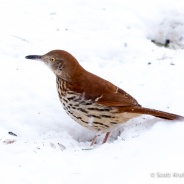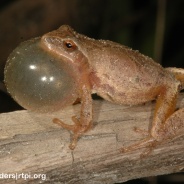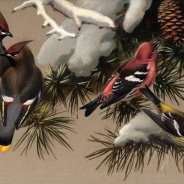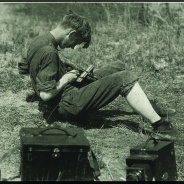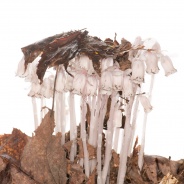I love this time of year. After the exuberance of summer and the vibrant colors of fall, I’m thankful for the days growing shorter. The nights longer. Temperatures falling. Silhouettes of bare branches against a leaden sky promising snow. All of nature winding down. Encouraging quiet. Reflection. Introspection. [more]
Winter Blues
Blue Jays (Cyanocitta cristata) can look so vibrantly blue on sunny days, but blue coloration in animals is very rarely created by blue pigment. Instead, their stunning hues are created by refractive colors of light, breaking on microscopic structure of the feathers. Minute barbs on their feathers are specially modified to scatter light in a way that makes them appear blue, rather than showing the brown melanin that their feathers are colored with. Yes, Blue Jays are not actually blue!
read moreBrown Thrasher Visit
This Brown Thrasher came to my feeders today! Talk about a welcome visitor…it ended up spending the day eating with various feathered friends, using that long bill to dig seed out of the snow. It was a delightful surprise for one of the more quiet times of the year. Scott Kruitbosch Conservation & Outreach Coordinator
read moreDark-eyed Junco
The Dark-eyed Junco (Junco hyemalis) is one of our most familiar backyard feeder birds. They are a species we can find year-round as they nest in some of our woodlands in western New York. They used to be known as the “snowbird” likely because of their abundance in pouring down from the north into all of the continental United States during the winter. Their plumage, grays and browns above with white below, also seem to fit so perfectly on a snowy landscape. This bird was photographed during a recent snowstorm looking regal as can...
read moreNot All Salamanders Are Newts…
If you’re an amphibian enthusiast, you’ve probably heard this phrase at some point: “All newts are salamanders but not all salamanders are newts.” Does trying to make sense of this cause smoke to come out of your ears? You’re not alone. To shed some light on this conundrum, let’s first consider a bit of taxonomy. Within the Class Amphibia there are three Orders: Caudata, Anura, and Gymnophiona. Caudata refers to the salamanders; species that retain their tails as adults and have four legs. These differ from...
read moreFrog Friday
Last Wednesday was an unusually warm day in the northeast. Temperatures reached 60 degrees in some places, and several of our friends in Connecticut reported hearing Spring Peeper calls emanating from the woods. Of course, a mere 24 hours later the area was buried by more than a foot of snow, reminding us that winter is still in full swing. You might think that frogs are not quite as adept at predicting winter weather as, say, groundhogs, but that is not really true. Our days are getting noticeably longer and the increased day length is...
read moreArtist Dale Weiler to Produce Bronze Owl Sculptures for RTPI
We are very excited to announce the release of a new bronze sculpture created by Dale Weiler to support wildlife conservation programs underway at The Roger Tory Peterson Institute of Natural History (RTPI) in Jamestown, NY. Roger Tory Peterson (1908-1996) was one of the nation’s pre-eminent bird-artists and among our most influential naturalists. He is perhaps best known for the Peterson Field Guide Series on birds and other flora and fauna. RTPI carries on his legacy by connecting people to nature through art, education and conservation....
read moreFeeder Birds of Newfoundland
This plate, titled “Feeder Birds” is from the 1951 book “Birds of Newfoundland”, by Harold S. Peters and Thomas D. Burleigh of the U.S. Fish & Wildlife Service. Peters and Burleigh were commissioned by the Newfoundland government to write the book to be used as a reference in schools, as well as for citizens and tourists of Newfoundland. The book covers 227 birds, and was illustrated with 32 color plates and 40 line drawings by Roger Tory Peterson. The Newfoundland and Labrador Tourist Development Office created a...
read more2016 Annual Report
Roger Tory Peterson lived his life by the motto “Learn it, Love it, Protect it”, and it’s a great way to characterize our work at RTPI! We endeavor to share with you the wonder and excitement of appreciating and exploring the natural world every day and everywhere. Please read our 2016 Annual Report to learn about the many ways that we’ve been continuing Roger Tory Peterson’s work! You can access the full report at http://rtpi.org/support-rtpi/2016-annual-report/ We hope you enjoy learning about our many...
read moreTreasure Hunt Tuesday; A Revolutionary Naturalist’s First Tools
Roger Tory Peterson’s obsession with birds prompted a lifelong interest in photography – what better way to capture fleeting encounters with his feathered fascinations? The following photograph depicts a 4×5″ Auto-Graflex camera of the type that Roger Tory Peterson utilized to photograph birds in his early career. Below that is a photo of a young Peterson in the field with his photographic tools. Over the course of his lifetime, Peterson amassed a collection of some one-million photographs; most of these reside in the RTPI archives...
read moreGhost Plant
Now that our outdoors are covered in white I thought it would be nice to post a splash of color to liven up the winter months. However, when looking through my plant images I noticed this picture of a clump of Indian Pipe (Monotropa uniflora) in the mix. Somehow their lack of color seemed appropriate for the time of year – and fascinating too. Lack of color in plants translates into a lack of chlorophyl, the pigments and associated cellular complexes that allow green plants to photosynthesize & turn solar energy into living matter,...
read more




